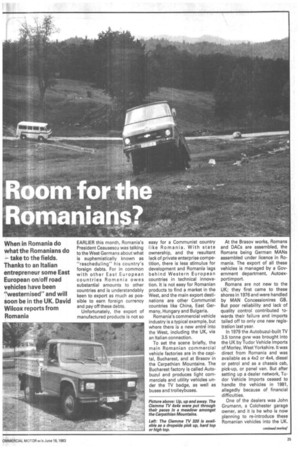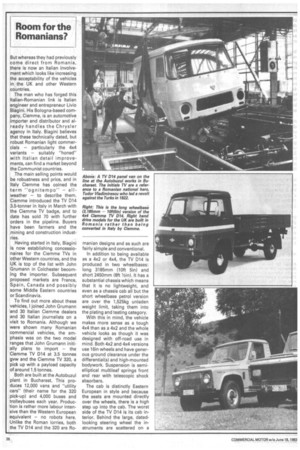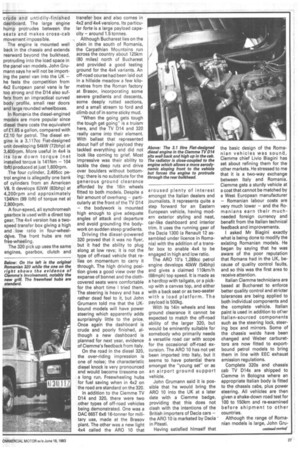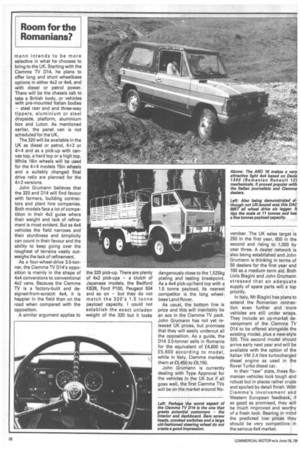When in Romania do what the Romanians do — take
Page 27

Page 28

Page 29

Page 30

If you've noticed an error in this article please click here to report it so we can fix it.
to the fields. Thanks to an Italian entrepreneur some East European on/off road vehicles have been "westernised" and will soon be in the UK. David Wilcox reports from Romania
EARLIER this month, Romania's President Ceausescu was talking to the West Germans about what is euphemistically known as "rescheduling" his country's foreign debts. For in common with other East European countries Romania owes substantial amounts to other countries and is understandably keen to export as much as possible to earn foreign currency and pay off these debts.
Unfortunately, the export of manufactured products is not so easy for a Communist country like Romania. With state ownership, and the resultant lack of private enterprise competition, there is less stimulus for development and Romania lags behind Western European countries in technical innovation. It is not easy for Romanian products to find a market in the West, and the main export destinations are other Communist countries like China, East Germany, Hungary and Bulgaria.
Romania's commercial vehicle industry is a typical example, but where there is a new entrO into the West, including the UK, via an Italian connection.
To set the scene briefly, the main Romanian commercial vehicle factories are in the capital, Bucharest, and at Brasov in the Carpathian Mountains. The Bucharest factory is called Autobuzul and produces light commercials and utility vehicles under the TV badge, as well as buses and trolleybuses. At the Brasov works, Romans and DACs are assembled, the Romans being German MANs assembled under licence in Romania. The export of all these vehicles is managed by a Government department, Autoexportimport.
Romans are not new to the UK; they first came to these shores in 1976 and were handled by MAN Concessionires GB. But poor reliability and lack of quality control contributed towards their failure and imports tailed off to only one new registration last year.
In 1979 the Autobuzul-built TV 3.5 tonne gvw was brought into the UK by Tudor Vehicle Imports of Morley, West Yorkshire. It was direct from Romania and was available as a 4x2 or 4x4, diesel or petrol and as a chassis cab, pick-up, or panel van. But after setting up a dealer network, Tudor Vehicle Imports ceased to handle the vehicles in 1981, allegedly because of financial difficulties.
One of the dealers was John Grumann, a Colchester garage owner, and it is he who is now planning to re-introduce these Romanian vehicles into the UK. But whereas they had previously come direct from Romania, there is now an Italian involvement which looks like increasing the acceptability of the vehicles in the UK and other Western countries.
The man who has forged this Italian-Romanian link is Italian engineer and entrepreneur Livio Biagini. His Bologna-based company, Ciemme, is an automotive importer and distributor and already handles the Chrysler agency in Italy. Biagini believes that these technically dated, but robust Romanian light commercials — particularly the 4x4 variants — suitably "honed" with Italian detail improvements, can find a market beyond the Communist countries.
The main selling points would be robustness and price, and in Italy Ciemme has coined the term "ognitempo" — allweather — to describe them. Ciemme introduced the TV D14 3.5-tonner in Italy in March with the Ciemme TV badge, and to date has sold 70 with further orders in the pipeline. Buyers have been farmers and the mining and construction industries.
Having started in Italy, Biagini is now establishing concessionaires for the Ciemme TVs in other Western countries, and the UK is top of the list with John Grumann in Colchester becoming the importer. Subsequent proposed markets are France, Spain, Canada and possibly some Middle Eastern countries or Scandinavia.
To find out more about these vehicles, I joined John Grumann and 30 Italian Ciemme dealers and 30 Italian journalists on a visit to Romania. Although we were shown many Romanian commercial vehicles, the emphasis was on the two model ranges that John Grumann initially plans to import — the Ciemme TV D14 at 3.5 tonnes gvw and the Ciemme TV 320, a pick up with a payload capacity of around 1.5 tonnes.
Both are built at the Autobuzul plant in Bucharest. This produces 12,000 vans and "utility cars" (their name for the 320 , pick-up) and 4,000 buses and trolleybuses each year. Production is rather more labour intensive than the Western European equivalent — no robots here. Unlike the Roman lorries, both the TV 014 and the 320 are Ro manian designs and as such are fairly simple and conventional.
In addition to being available as a 4x2 or 4x4, the TV D14 is produced in two wheelbases: long 3185mm (10ft Sin) and short 2450mm (8ft 1/21n). It has a substantial chassis which means that it is no lightweight, and even as a chassis cab all but the short wheelbase petrol version are over the 1,525kg unladen weight limit, taking them into the plating and testing category.
With this in mind, the vehicle makes more sense as a tough 4x4 than as a 4x2 and the whole vehicle looks as though it was designed with off-road use in mind. Both 4x2 and 4x4 versions use 16in wheels and have generous ground clearance under the differential(s) and high-mounted bodywork. Suspension is semielliptical multileaf springs front and rear with telescopic shock absorbers.
The cab is distinctly Eastern European in style and because the seats are mounted directly over the wheels, there is a high step up into the cab. The worst side of the TV 014 is its cab interior. Behind the large, datedlooking steering wheel the instruments are scattered on a crude and untidily-finished dashboard. The large engine hump protrudes between the seats and makes cross-cab movement impossible.
The engine is mounted well back in the chassis and extends rearward beyond the bulkhead, protruding into the load space in the panel van models. John Grumann says he will not be importing the panel van into the UK — he feels the competition from 4x2 European panel vans is far too strong and the D14 also sufferx from an impractical curved body profile, small rear doors and large rounded wheelboxes.
In Romania the diesel-engined models are more popular since diesel there costs the equivalent of f1.65 a gallon, compared with E2.10 for petrol. The diesel engine is a 3,117cc Fiat-designed unit developing 54kW (72bhp) at 3,400rpm. More useful in 4x4 is its low down torque (net installed torque is 141Nm — 104 Ibft) produced at just 1,600rpm.
The four cylinder, 2,495cc petrol engine is allegedly one bank of cylinders from an American V8. It develops 62kW (83bhp) at 4,200rpm and approximately 134Nm (99 Ibft) of torque net at 2,90Orpm.
A four-speed, all synchromesh gearbox is used with a direct top gear. The 4x4 version has a twospeed transfer box giving a high and low ratio in four-wheeldive. The front hubs are not free-wheeling.
The 320 pick up uses the same engines, gearbox, clutch and transfer box and also comes in 4x2 and 4x4 versions. Its particular forte is a large payload capacity — around 1.5 tonnes.
Although Bucharest lies on the plain in the south of Romania, the Carpathian Mountains run across the country about 125km (80 miles) north of Bucharest, and provided a good testing ground for the 4x4 variants. An off-road course had been laid out in a hillside meadow a few kilometres from the Roman factory at Brasov, incorporating some severe gradients and descents, some deeply rutted sections, and a small stream to ford and climb out of in some sticky mud.
"When the going gets tough the tough get going" is a truism here, and the TV D14 and 320 really came into their element. With ballast that represented about half of their payload they tackled everything and did not look like coming to grief. Most impressive was their ability to tackle the deep ruts and drive over boulders without bottoming; there is no substitute for the generous ground clearance afforded by the 16in wheels fitted to both models. Despite a fair amount of overhang — particularly at the front of the TV D14 — the bodywork is mounted high enough to give adequate angles of attack and departure and avoid grounding the bodywork on sudden steep gradients.
Driving the diesel-powered 320 proved that it was no flyer, but it had the ability to plug along at low revs; it is not the type of off-road vehicle that relies on momentum to carry it through. The high driving position gives a good view over the expanse of bonnet and the clothcovered seats were comfortable for the short time I tried them. The steering is heavy and has a rather dead feel to it, but John Grumann told me that the UKbound models will have power steering which apparently adds surprisingly little to the price. Once again the dashboard is crude and poorly finished, although a new dashboard is planned for next year, evidence of Ciemme's feedback from Italy.
On the road in the diesel 320, the over-riding impression is one of noise; the characteristic diesel knock is very pronounced and would become tiresome on a long run. Freewheeling hubs for fuel saving when in 4x2 on the road are standard on the 320.
In addition to the Ciemme TV D14 and 320, there were two other types of off-road vehicles being demonstrated. One was a DAC 665T 6x6 16-tonne r for military use, made at the Brasov plant. The other was a new light 4x4 called the ARO 10 that
aroused plenty of interest amongst the Italian dealers and journalists. It represents quite a step forward for an Eastern European vehicle, having modern exterior styling and neat, car-like dashboard and interior trim. It uses the running gear of the Dacia 1300 (a Renault 12 assembled under licence in Romania) with the addition of a transfer box to enable 4x4 to be engaged in high and low ratio.
The ARO 10's 1,289cc petrol engine develops 40kW (54bhp) and gives a claimed 110km/h (68mph) top speed. It is made as a hardtop with tailgate, or a pickup with a canvas top, and either with a back seat or as two-seater with a load platform. The payload is 500kg.
With its 14in wheels and less ground clearance it cannot be expected to match the off-road ability of the larger 320, but would be eminently suitable for somebody who primarily needs a versatile road car with scope for the occasional off-road excursion. The ARO 10 has not yet been imported into Italy, but it seems to have potential there amongst the "young set" or as an airport ground support vehicle.
John Grumann said it is possible that he would bring the ARO 10 into the UK at a later date with a Ciemme badge, providing that this does not clash with the intentions of the British importers of Dacia cars — the ARO 10 is marketed by Dacia in Pitesti.
Having satisfied himself that the basic design of the Romanian vehicles was sound, Ciemme chief Livio Biagini has set about refining them for the other markets. He stressed to me that it is a two-way exchange between Italy and Romania. Ciemme gets a sturdy vehicle at a cost that cannot be matched by a West European manufacturer — Romanian labour costs are very much lower — and the Romanians earn their muchneeded foreign currency and benefit from the Italian technical feedback and improvements.
I asked Mr Biagini exactly what is being done to modify the existing Romanian models. He began by saying that he was aware of the poor reputation that Romans had in the UK, because of quality control faults, and so this was the first area to receive attention.
Italian Ciemme technicians are based at Bucharest to enforce better quality control and stricter tolerances are being applied to both individual components and the complete vehicle. Italian paint is used in addition to other Italian-sourced components such as the steering lock, steering box and mirrors. Some of the chassis welds have been changed and Weber carburettors are now fitted to exportbound petrol models to bring them in line with EEC exhaust emission regulations.
Complete 320s and chassis cab TV D14s are shipped to Ciemme in Bologna where an appropriate Italian body is fitted to the chassis cabs, plus power steering. All vehicles are then given a shake-down road test for 100 to 150km and re-examined before shipment to other countries.
Although the range of Romanian models is large, John Gru mann intends to be more selective in what he chooses to bring to the UK. Starting with the Ciemme TV 014, he plans to offer long and short wheelbase options in either 4x2 or 4x4, and with diesel or petrol power. There will be the chassis cab to take a British body, or vehicles with pre-mounted Italian bodies — steel rear end and three-way tippers, aluminium or steel dropside, platform, aluminium box and Luton. As mentioned earlier, the panel van is not scheduled for the UK.
The 320 will be available in the UK as diesel or petrol, 4x2 or 4x4 and as a pick-up with canvas top, a hard top or a high top. While 16in wheels will be used for the 4x4 models 15in wheels and a suitably changed final drive ratio are planned for the 4x2 versions.
John Grumann believes that the 320 and D14 will find favour with farmers, building contractors and plant hire companies. Both models face a lot of competition in their 4x2 guise where their weight and lack of refinement is most evident. But as 4x4 vehicles the field narrows and their sturdiness and simplicity can count in their favour and the ability to keep going over the roughest of terrains vastly outweighs the lack of refinement.
As a four-wheel-drive 3.5-tonner, the Ciemme TV D14's opposition is mainly in the shape of 4x4 conversions to conventional 4x2 vans. Because the Ciemme TV is a factory-built and designed-from-scratch 4x4, it is happier in the field than on the road when compared with the opposition.
A similar argument applies to
the 320 pick-up. There are plenty of 4x2 pick-ups — a clutch of Japanese models, the Bedford KB26, Ford P100, Peugeot 504 and so on — but they do not match the 320's 1.5 tonne payload capacity. I could not establish the exact unladen weight of the 320 but it looks
dangerously close to the 1,525kg plating and testing breakpoint. As a 4x4 pick-up/hard top with a 1.5 tonne payload, its nearest competitor is the long wheelbase Land Rover.
As usual, the bottom line is price and this will inevitably be an ace in the Ciemme TV pack. John Grumann has not yet released UK prices, but promises that they will easily undercut all the opposition. As a guide, the D14 3.5-tonner sells in Romania for the equivalent of £4,600 to £5,600 according to model, while in Italy, Ciemme markets them at £5,450 to £6,150.
John Grumann is currently dealing with Type Approval for the vehicles in the UK but if all goes well, the first Ciemme TVs will be on the market around No vember. The UK sales target is 250 in the first year, 600 in the second and rising to 1,000 by year three. A dealer network is also being established and John Grumann is thinking in terms of 50 dealers for the first year and 100 as a medium term aid. Both Livio Biagini and John Grumann stressed that an adequate supply of spare parts will a top priority.
In Italy, Mr Biagini has plans to extend the Romanian connection even further and more vehicles are still under wraps. They include an up-market development of the Ciemme TV 014 to be offered alongside the existing model, plus a new-style 320. This second model should arrive early next year and will be available with the option of the Italian VM 2.4 litre turbocharged diesel engine as used in the Rover Turbo diesel car.
In their "raw" state, these Romanian vehicles look tough and robust but in places rather crude and spoiled by detail finish. With Ciemmers involvement and Western European feedback, if as good as promised, they will be much improved and worthy of a fresh look. Bearing in mind the predicted low prices they should be very competitive in the serious 4x4 market.








































































































